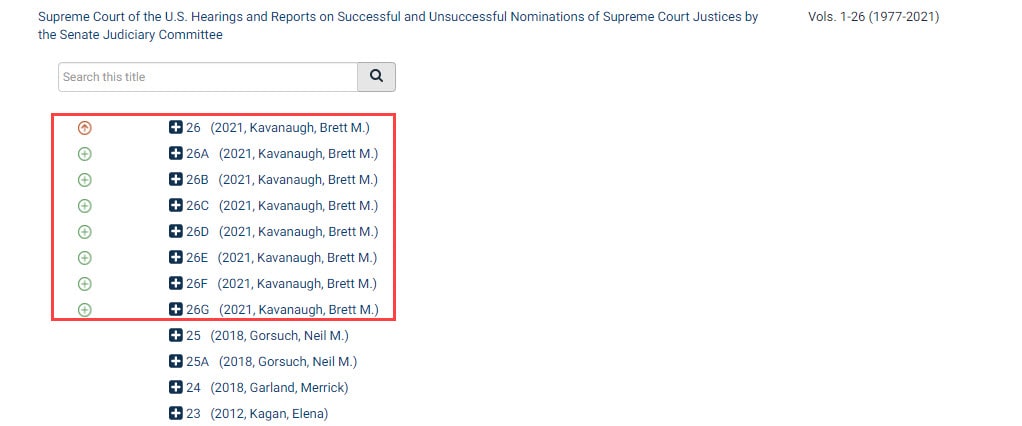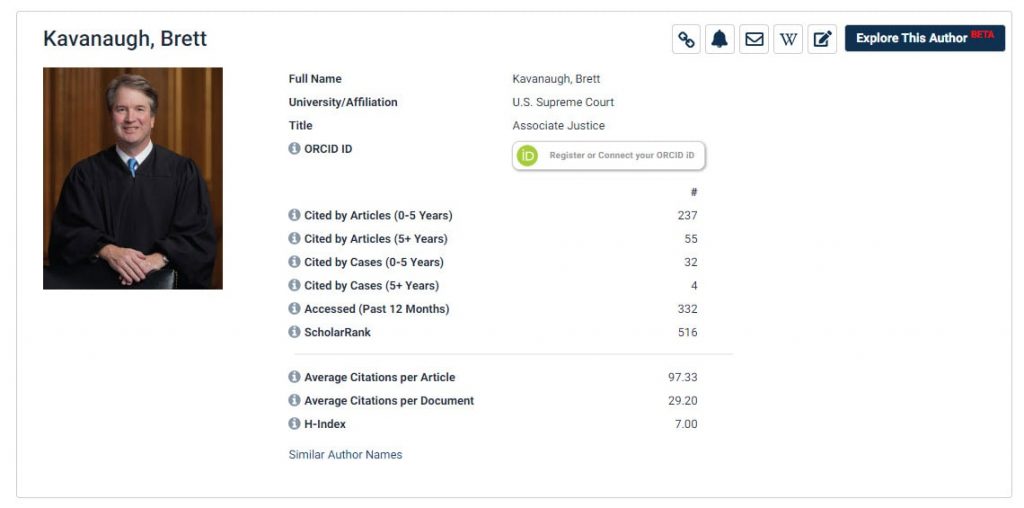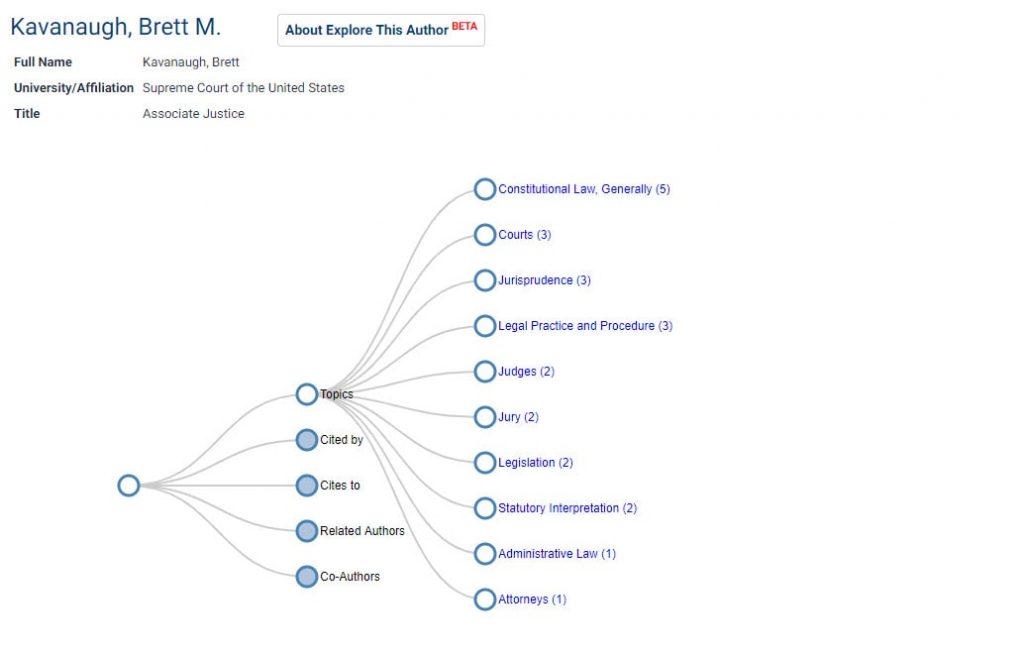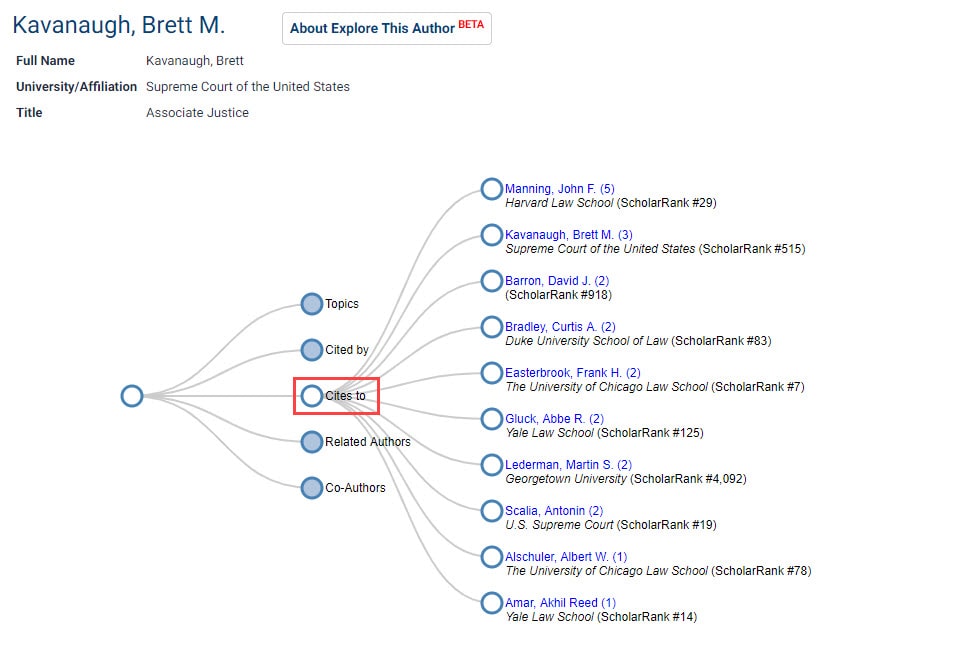HeinOnline is pleased to announce that we’ve now completed the online volumes in The Supreme Court of the United States: Hearings and Reports on Successful and Unsuccessful Nominations of Supreme Court Justices by the Senate Judiciary Committee. We were able to complete this series with the latest release of Associate Justice Brett Kavanaugh’s nomination hearings, material so voluminous that it comprises 8 volumes. Find it all in HeinOnline’s History of Supreme Court Nominations database.
Dive into this post to learn a bit more about Associate Justice Kavanaugh, his background, and his time on the Supreme Court.
Kavanaugh’s Background and Nomination
Education and Early Work
After attending high school at Georgetown Preparatory School in Bethesda, Maryland, Brett Kavanaugh enrolled at Yale University in 1983 to study history. Remembered as a “serious” student, he graduated with a Bachelor of Arts cum laude in history in 1987. From there, Kavanaugh went on to attend Yale Law School where he contributed to the Yale Law Journal, serving as a notes editor in his third year. Upon graduation, he first worked as a law clerk on the United States Court of Appeals for the Third Circuit. A few years later, he worked as a clerk for Supreme Court Justice Anthony Kennedy (whom he would later replace) alongside colleague and former schoolmate Neil Gorusch.
Following his year working with the Supreme Court, Kavanaugh worked for Solicitor General of the United States, Ken Starr as an Associate Counsel in the Office of the Independent Counsel. In 1998, Kavanaugh argued a case (for Starr’s office) for the first time before the Supreme Court, but his arguments were rejected by a vote of 6-3. Later that year, Kavanaugh was one of the main authors of the Starr Report on the investigation of the Clinton-Lewinsky scandal, recommending Clinton’s impeachment.
In 2000, Kavanaugh became acquainted with President-Elect George W. Bush as a member of his legal team. He was then nominated by Bush to the United States Court of Appeals for the D.C. Circuit in 2003, though his nomination would be delayed for nearly three years due to controversy over his alleged partisanship.
Supreme Court Nomination
On July 9, 2018, Kavanaugh was nominated by President Donald Trump to fill Justice Anthony Kennedy’s vacant spot on the Supreme Court. Later that month, psychology professor Christine Blasey Ford confidentially shared with Senator Dianne Feinstein that Kavanaugh had sexually assaulted her while they were in high school. Feinstein provided the FBI with the allegation on September 14 (after Kavanaugh’s nomination hearings and six days before the Judiciary Committee was scheduled to vote on his final consideration).
Ford’s claims were made public two days later; Kavanaugh then publicly denied the allegations on September 17. In the following weeks, two other women alleged that Kavanaugh had sexually assaulted them as well, and an accusation of rape surfaced from an anonymous source. During the ensuing FBI investigation, alleged eyewitnesses to the first two accusations denied witnessing the event, and both women subsequently demonstrated uncertainty about their allegations. The anonymous source later came forward to say that her accusations were false; she was referred to the Department of Justice and FBI for false accusations and obstruction of justice.
On September 27, the Senate Judiciary Committee held a supplementary day of public hearings to discuss the allegations with two witnesses present—Brett Kavanaugh and Christine Blasey Ford. Ford repeated her earlier claims and provided more information, mentioning a friend who was present during the alleged incident. The friend (Leland Keyser) ultimately stated she had no memory of the alleged misconduct or the event where it supposedly took place, and later claimed that during the nomination process, she felt pressured by many to “remember something different.” The resulting FBI investigation found no evidence to corroborate any of the allegations, but has since been harshly criticized by many for its limited scope.
Regardless, on October 6, the Senate confirmed Kavanaugh to the Supreme Court with a historically close 50-48 vote—all Democrats but one voted against his nomination, and all Republicans voted in favor.
Work on the Supreme Court
Over his time on the Court so far, Kavanaugh’s voting record has demonstrated a more moderate mindset than previously thought, though markedly more conservative than his predecessor Anthony Kennedy. Kavanaugh has been shown to vote with liberal justices almost as often (if not just as often) as his conservative colleagues.
Kavanaugh joined conservative justices on these notable cases:
- Rucho et al. v. Common Cause et al. (2019)
- Kavanaugh’s Take: He joined the majority opinion stating that federal courts cannot review allegations of partisan gerrymandering (and thus strike down electoral districts that favor a political party).
- Nielsen v. Preap (2019)
- Kavanaugh’s Take: He joined the majority opinion (and wrote his own) stating that the U.S. government has the power to detain any immigrants with a history of crimes that could lead to their deportation, regardless of when those crimes were committed.
- Bucklew v. Precythe (2019)
- Kavanaugh’s Take: He joined the majority opinion stating that convicts who claim that the State’s method of execution would cause them excessive pain must provide alternative methods of execution that would be undisputedly less painful.
- Bostock v. Clayton County (2020)
- Kavanaugh’s Take: He joined the dissenting opinion stating that the Civil Rights Act of 1964 does not protect employees against discrimination based on sexual orientation or gender identity, because those concepts were unknown at the time. He wrote his own opinion to add that the Court could not add those concepts to Title VII due to separation of powers—this responsibility lies with Congress.
- McGirt v. Oklahoma (2020)
- Kavanaugh’s Take: He joined the dissenting opinion stating that when Oklahoma joined the Union, the Five Tribes, the state of Oklahoma, and Congress had recognized that the previous domains of the tribes were eliminated. Furthermore, the opinion stated that the Creek Nation had previously acknowledged that it no longer possessed the reservation in question. Read more about McGirt v. Oklahoma in this blog post.
However, on these cases, for example, Kavanaugh sided with his liberal colleagues:
- Apple Inc. v. Pepper (2019)
- Kavanaugh’s Take: He joined the majority opinion that Apple’s consumers were “direct purchasers” when it came to Apple store applications, and therefore they had Article III standing under federal antitrust laws to bring class-action antitrust lawsuits against the company for its Store regulations and practices.
- Trump v. Vance (2020)
- Kavanaugh’s Take: He joined the majority opinion that every citizen, including the president, must produce evidence when called upon during a criminal proceeding, ruling that President Donald Trump must produce his tax returns and financial records for a New York City prosecutor.
- Trump v. Mazars USA (2020)
- Kavanaugh’s Take: He joined the majority opinion acknowledging that the legislative branch has the power to subpoena the executive branch and its records, while setting certain limits on this power.
Overall, Justice Kavanaugh has demonstrated that his decision-making and jurisprudence aligns most often with Chief Justice John Roberts, who has been observed to have a more moderate conservative orientation. With the addition of Amy Coney Barrett in October of 2020 (another presumed conservative justice now demonstrating a more moderate stance), Supreme Court cases seem to be more likely to result in the rare 3-3-3 decision: Alito, Gorusch, and Thomas leaning right; Roberts, Kavanaugh, and Barrett at the center; and Breyer, Sotomayor, and Kagan leaning left.
Learn More about Brett Kavanaugh in HeinOnline
History of Supreme Court Nominations
HeinOnline’s History of Supreme Court Nominations features the complete series of Supreme Court of the U.S. Hearings and Reports on Successful and Unsuccessful Nominations of Supreme Court Justices by the Senate Judiciary Committee by Roy M. Mersky and J. Myron Jacobstein. In addition, users can search more than 350 titles containing relevant government documents, scholarly articles, and bibliographies applicable to each Supreme Court Justice.
Each compilation of nomination documents includes the following:
- Confirmation hearing and transcript on the nomination
- Senate Judiciary Committee vote on the nomination
- Memoranda drafted
- Presidential statements
- Resignation announcements
- Pre-nomination speculation
- Nomination announcement
- Confirmation date
The Browse by Justice option allows users to link directly to relevant content for each justice. Also included are more than 350 titles related to the Supreme Court, links to scholarly articles, and bibliographies.

Find the eight volumes relating to Kavanaugh’s nomination here.

Law Journal Library
With HeinOnline’s Law Journal Library, users can research Kavanaugh and his views on various topics. Begin by checking out his author profile page.

On his author profile page, find a list of Justice Kavanaugh’s works as well as their citation and access metrics. See his three most-cited articles here:
- Fixing Statutory Interpretation
Harvard Law Review, Vol. 129, Issue 8 (June 2016), pp. 2118-2163 - The President and the Independent Counsel
Symposium: The Independent Counsel Act: From Watergate to Whitewater and Beyond: Contribution
Georgetown Law Journal, Vol. 86, Issue 6 (July 1998), pp. 2133-2178 - Defense Presence and Participation: A Procedural Minimum for Batson v. Kentucky Hearings
Yale Law Journal , Vol. 99, Issue 1 (October 1989), pp. 187-208
Check out HeinOnline’s Explore This Author feature from within Kavanaugh’s author profile page to learn more about his scholarly work. With this feature, users can see his most-discussed topics, his co-authors, cited works, and much more.
Click the Explore This Author button from his profile.

Interact with the diagram to see interesting information about the author. For example, click the Cites to option to see all the authors that Kavanuagh has cited.

Then, click any of those author names to see the articles that Kavanaugh cited in his scholarly work.
More on the Supreme Court from the HeinOnline Blog
For even more content, check out these blog posts on the Supreme Court:
- All About President Biden’s New Supreme Court Commission
- Marbury v. Madison: The Most Important Decision in American Constitutional Law
- Everything You Need to Know About Supreme Court Nominee Amy Coney Barrett
- I Dissent: The Life and Legacy of the Incomparable Ruth Bader Ginsburg
- McGirt v. Oklahoma: A Historic Win for Native American Rights
- Reigning Supreme: All About the Highest Court in the United States



